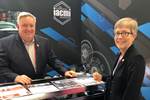Final perspectives and provocations
As Dale Brosius winds down his Perspectives & Provocations column, he reminisces on its start in 2013 and offers some parting thoughts on the trends and technologies that are shaping the composites industry.

JEC 2013, a rare time when Paris, France, was blanketed in snow, and two days before the conception of the Perspectives & Provocations column was born. Photo Credit: Dale Brosius
Well, this is it — my 100th and final scheduled Perspectives & Provocations column for CompositesWorld. This seems a suitable milestone at which to step away, although I may make a guest appearance every now and then.
I’ve written before how the late Sara Black invited me to dinner with her and Jeff Sloan in Paris during JEC 2013 to discuss “an idea they had” — the very same week that snow accumulated in Paris, the first I’d experienced in my 30+ years of JECs. She asked me to pick the place, so I chose a small left-bank bistro my wife and I had discovered while stuck in Paris after JEC 2010, when the Iceland volcano Eyjafjallajökull erupted. They asked me if I would consider authoring a monthly column, an op-ed if you will, for CW. Pick your own topics, write what you like, here’s your soapbox. It was Mike Musselman, CW’s managing editor at the time, that suggested the Perspectives & Provocations tagline, noting my long experience and willingness to poke and prod the composites industry.
My first column in June 2013 asked whether anyone would follow BMW’s lead in the just-introduced carbon fiber-intensive i3 and i8 vehicles. Not only did no OEM follow, the last i3 rolled off the assembly line this June, exactly mirroring my nine-year run of columns. Along the way, we’ve seen the rise of large-format additive manufacturing, major advances in composites recycling, increased automation and the introduction of Industry 4.0 technologies to composites manufacture. Large advances have also been made in composites simulation and structural thermoplastics. And we shouldn’t forget that there have been numerous acquisitions of composites-related companies, and we have endured a global pandemic that disrupted supply chains and accelerated a move to cleaner energy use and generation.
Enough reminiscing. I still have license to be provocative, so here goes…
We haven’t solved the carbon fiber cost riddle for automotive applications — certainly not enough to meet the moment — time and time again. With automated processing and much reduced cycle times, it still comes down to fiber cost and reducing material scrap. Battery electric vehicles (BEVs) offer a higher value for weight savings, but still way less than aerospace. In addition to cost, we have to also solve the CO2 footprint of making carbon fiber, be that precursors other than those derived from petroleum, bio-based PAN, dry spinning or other technologies.
There is still a lot to learn about this exciting industry we call composites.
Offshore wind turbines are a giant focus of governments and OEMs alike, with a U.S. goal of 30 gigawatts (GW) of offshore wind electricity by 2030. Perhaps 250-meter rotor diameters will help mitigate production costs, but offshore wind today is more than twice the cost of onshore wind. To meet the demand for a net-zero energy goal by 2035, we will still need a lot more onshore wind turbines. We must invest in ways to build larger onshore turbines that get around transportation restrictions. Jointed blades or on-site fabrication are possible solutions.
Hydrogen is the darling of the moment, but producing cheap green hydrogen will require almost free green electricity, which will favor batteries for powering most transportation. Specific cases could favor hydrogen-heavy trucks, airplanes and ocean freight, for example. There will be growth in composite tanks for compressed hydrogen, but the big breakthrough for composites will be in storing liquid hydrogen in cryogenic tanks, assuming we can overcome some technical hurdles.
With the rebound in air traffic, and increasing pressure on reducing carbon emissions from flying, I think we are truly getting closer to seeing a significant adoption of carbon fiber in single-aisle aircraft, starting with wing assemblies and eventually fuselages, the latter possibly produced with thermoplastics. And while urban air mobility (UAM), or flying taxis, attract lots of attention, there are still many issues to overcome before this business can fully take off (pun intended), with composites being one of the lesser concerns.
Finally, the time has never been riper to see widespread acceptance of sustainable infrastructure made with composites. Composite rebar has nothing left to prove and needs to become the de facto choice. As fresh water becomes scarcer, especially on islands and along coasts, composite rebar enables concrete made with seawater. And we have the technology for drop-in replacements for inadequate and old rural bridges. It’s time to exploit that.
I’ve really enjoyed writing these 100 columns, especially the freedom to pick my topics, although writing through the depths of the COVID-19 pandemic was tough. I’m not leaving the industry — I still have a lot to do at IACMI, and you’ll see me at industry trade shows and conferences. There is still a lot to learn about this exciting industry we call composites.
Read Next
Impressions and takeaways from JEC World 2022
Suffice to say that JEC World 2022, the “Big Show” for the composites industry, exceeded many expectations. Dale Brosius contemplates pervasive themes, conversations and takeaways from the international event.
Read MoreNext-gen fan blades: Hybrid twin RTM, printed sensors, laser shock disassembly
MORPHO project demonstrates blade with 20% faster RTM cure cycle, uses AI-based monitoring for improved maintenance/life cycle management and proves laser shock disassembly for recycling.
Read MoreScaling up, optimizing the flax fiber composite camper
Greenlander’s Sherpa RV cab, which is largely constructed from flax fiber/bio-epoxy sandwich panels, nears commercial production readiness and next-generation scale-up.
Read More





















